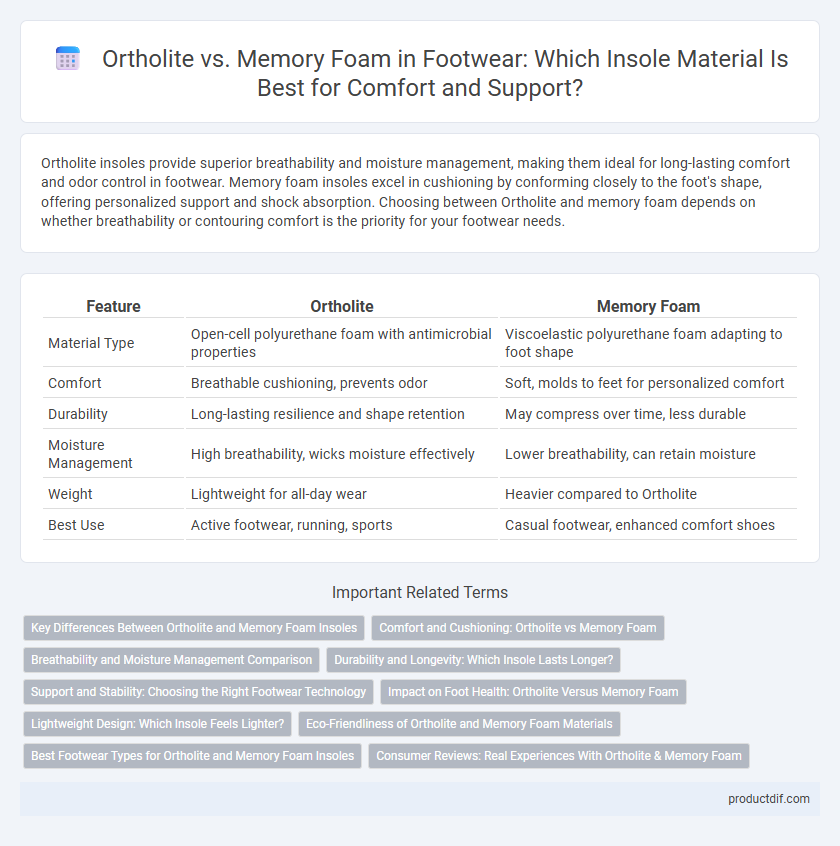Ortholite insoles provide superior breathability and moisture management, making them ideal for long-lasting comfort and odor control in footwear. Memory foam insoles excel in cushioning by conforming closely to the foot's shape, offering personalized support and shock absorption. Choosing between Ortholite and memory foam depends on whether breathability or contouring comfort is the priority for your footwear needs.
Table of Comparison
| Feature | Ortholite | Memory Foam |
|---|---|---|
| Material Type | Open-cell polyurethane foam with antimicrobial properties | Viscoelastic polyurethane foam adapting to foot shape |
| Comfort | Breathable cushioning, prevents odor | Soft, molds to feet for personalized comfort |
| Durability | Long-lasting resilience and shape retention | May compress over time, less durable |
| Moisture Management | High breathability, wicks moisture effectively | Lower breathability, can retain moisture |
| Weight | Lightweight for all-day wear | Heavier compared to Ortholite |
| Best Use | Active footwear, running, sports | Casual footwear, enhanced comfort shoes |
Key Differences Between Ortholite and Memory Foam Insoles
Ortholite insoles offer breathable, open-cell foam that promotes moisture management and long-lasting cushioning, while memory foam insoles prioritize personalized comfort by contouring to the foot's shape for pressure relief. Ortholite typically provides lightweight durability with antimicrobial properties, whereas memory foam tends to compress over time and may retain heat. The choice between the two depends on preferences for breathability and moisture control versus adaptive cushioning and support.
Comfort and Cushioning: Ortholite vs Memory Foam
Ortholite insoles offer long-lasting breathability and moisture management with open-cell foam that maintains cushioning over time, making them ideal for sustained comfort. Memory foam insoles conform closely to the foot's shape, providing personalized cushioning that absorbs shock and reduces pressure points effectively. Comfort preferences depend on activity level and foot shape, with Ortholite favoring durability and airflow, while memory foam excels in adaptive support and softness.
Breathability and Moisture Management Comparison
Ortholite insoles offer superior breathability due to their open-cell foam construction that enhances airflow and reduces heat buildup inside footwear. In contrast, memory foam retains more heat and moisture as it conforms closely to the foot, which can inhibit ventilation and lead to increased perspiration. Ortholite's moisture-wicking properties effectively manage sweat and maintain a drier environment, while memory foam insoles may trap moisture longer, potentially causing discomfort during extended wear.
Durability and Longevity: Which Insole Lasts Longer?
Ortholite insoles are known for their exceptional durability, retaining cushioning and structural integrity for over 1,000 miles of wear due to their open-cell foam technology. Memory foam insoles, while offering superior initial comfort by molding closely to the foot, tend to compress and lose support more quickly, often within 6 to 12 months depending on usage. For long-term longevity and consistent performance, Ortholite insoles typically outlast memory foam by maintaining their resilience and moisture-wicking properties over extended periods.
Support and Stability: Choosing the Right Footwear Technology
Ortholite insoles provide superior support and stability through a breathable, open-cell foam that maintains cushioning and structural integrity over time, making them ideal for high-impact activities. Memory foam conforms closely to the foot's shape for personalized comfort but may offer less long-term stability, potentially leading to reduced support during extended wear. Selecting between Ortholite and memory foam depends on prioritizing consistent support and durability versus customized cushioning.
Impact on Foot Health: Ortholite Versus Memory Foam
Ortholite insoles provide superior breathability and moisture-wicking properties that reduce foot odor and prevent fungal infections, promoting overall foot health. Memory foam insoles excel in cushioning by evenly distributing pressure and absorbing shock, which can alleviate joint pain and enhance comfort during prolonged wear. Choosing between Ortholite and memory foam depends on balancing moisture management with cushioning needs to optimize foot support and health.
Lightweight Design: Which Insole Feels Lighter?
Ortholite insoles feature an open-cell foam structure that enhances breathability and reduces weight, making them feel lighter than memory foam. Memory foam insoles, while providing superior cushioning and pressure relief, tend to be denser and heavier due to their viscoelastic properties. For lightweight design prioritization, Ortholite offers a more minimal feel, ideal for running shoes and casual footwear where reduced insole weight enhances overall comfort.
Eco-Friendliness of Ortholite and Memory Foam Materials
Ortholite insoles are crafted from open-cell polyurethane foam with recycled rubber and bio-oil components, enhancing breathability and promoting sustainability through partial use of renewable materials. Memory foam typically relies on petroleum-based materials, contributing to higher environmental impact due to non-biodegradability and energy-intensive manufacturing. Choosing Ortholite over memory foam supports eco-friendly footwear by reducing carbon footprint and improving long-term comfort with antimicrobial properties.
Best Footwear Types for Ortholite and Memory Foam Insoles
Ortholite insoles are best suited for athletic shoes, hiking boots, and casual sneakers due to their breathability, moisture-wicking properties, and long-lasting cushioning that enhance comfort during high-impact activities. Memory foam insoles excel in dress shoes, walking shoes, and casual footwear by providing personalized cushioning that molds to the foot's shape, reducing pressure points and improving comfort for extended wear. Choosing the right insole depends on activity type and comfort preferences, with Ortholite favored for performance footwear and Memory foam optimal for all-day support and style versatility.
Consumer Reviews: Real Experiences With Ortholite & Memory Foam
Consumer reviews reveal Ortholite insoles excel in breathability and long-term cushioning, maintaining comfort throughout extended wear. Memory foam insoles receive praise for immediate softness and excellent shock absorption, though some users note they may compress over time, reducing support. Both materials cater to different preferences, with Ortholite favored for durability and cooling, while memory foam is preferred for plush, conforming comfort.
Ortholite vs Memory Foam Infographic

 productdif.com
productdif.com